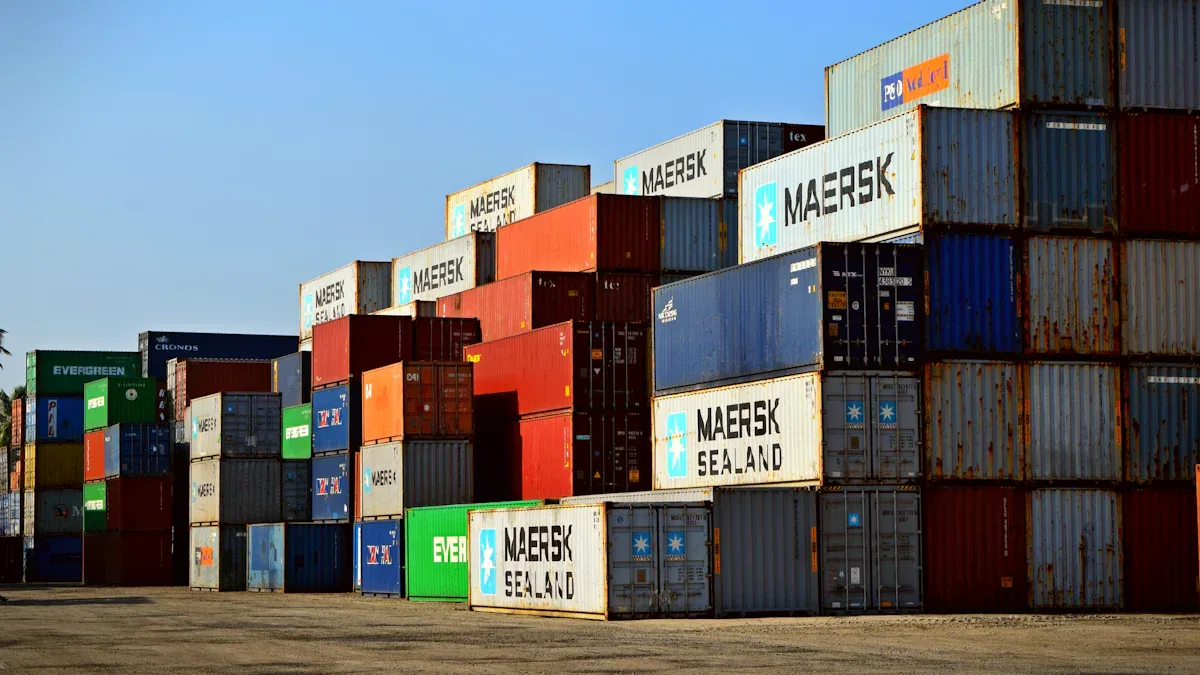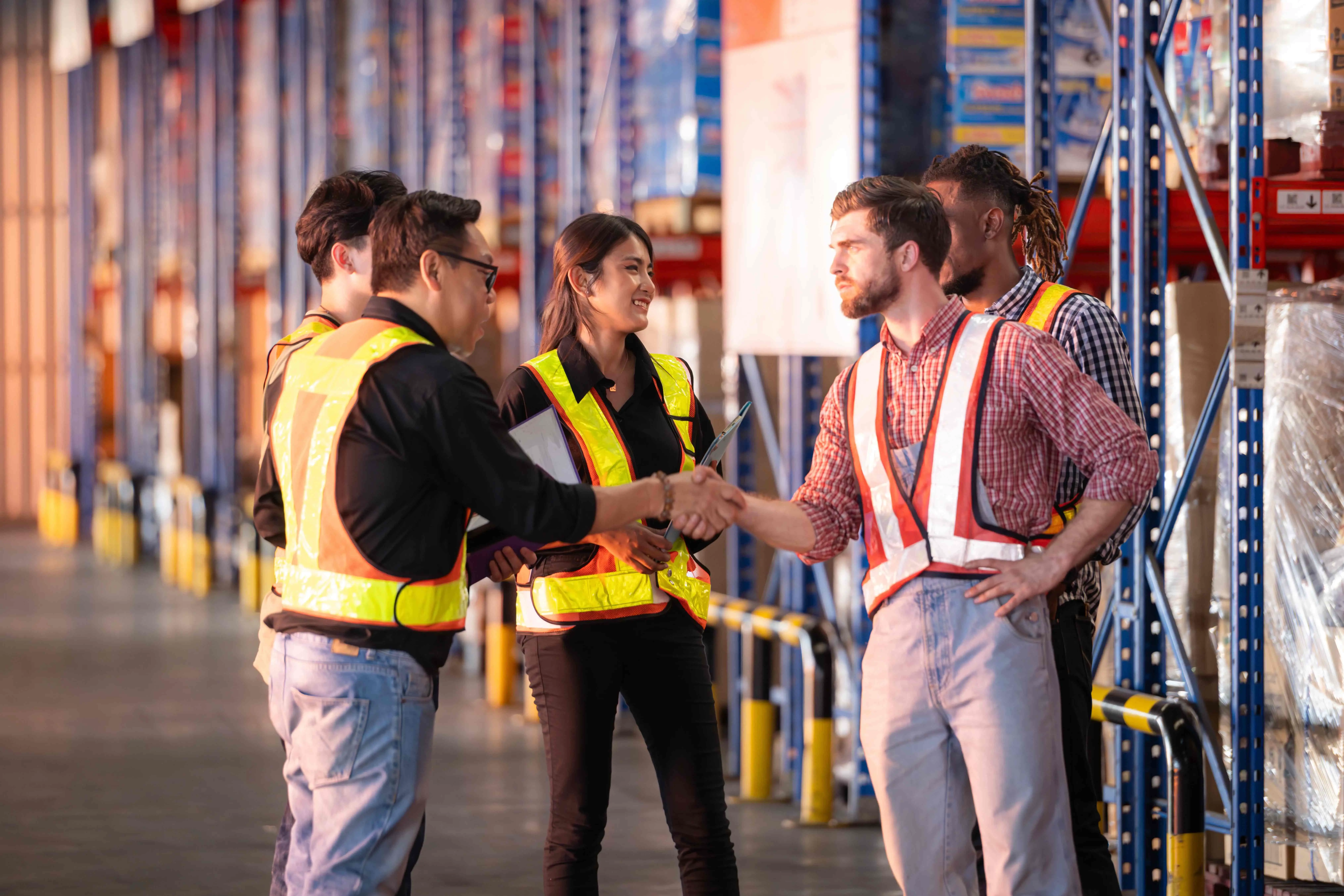Emerging Trends Shaping the Logistics Industry in 2025

The logistics industry is experiencing unprecedented growth, fueled by innovation and global demand. In 2023, its market size reached $3,794.4 billion, with projections to hit $5,951.0 billion by 2030. Technologies like AI, IoT, and robotics are transforming operations, enabling real-time tracking and predictive analytics. These advancements ensure faster, smarter logistics solutions.
Key Takeaways
Use tools like AI and IoT to make logistics faster and cheaper.
Follow eco-friendly methods to protect the planet and please customers.
Improve customer service with live tracking and easy delivery choices.
The Current State of the Logistics Industry
The Role of Logistics in Global Trade
Logistics plays a vital role in connecting businesses and consumers across the globe. It ensures the smooth movement of goods, enhancing supply chain management and supporting economic growth. With advancements in technology and infrastructure, logistics has become more efficient, enabling faster transportation and better coordination. The rise of e-commerce has further amplified its importance, as businesses rely on logistics to meet growing consumer demands. By facilitating trade and improving supply chain efficiency, the logistics sector contributes significantly to the global economy.
Challenges in the Logistics Sector Today
The logistics sector faces several challenges that require immediate attention.
Labor shortages remain a pressing issue, with over 70% of companies struggling to fill positions. Recruiting skilled workers, especially those with data analysis expertise, has become increasingly difficult.
Geopolitical tensions and evolving trade agreements disrupt supply chains, creating uncertainty for businesses.
Sustainability pressures demand eco-friendly practices, pushing companies to adopt greener solutions.
Cybersecurity threats have risen due to the digitization of supply chains, necessitating robust protective measures.
Consumer expectations for transparency and customization are driving the need for advanced technologies.
These challenges highlight the need for innovative strategies to ensure the logistics sector remains resilient and adaptable.
Opportunities for Innovation and Growth
Despite its challenges, the logistics sector offers immense opportunities for growth. Companies are leveraging technology to address inefficiencies and improve operations.
AI and machine learning enable demand forecasting and route optimization, reducing costs and delays.
IoT devices provide real-time tracking of shipments, enhancing transparency and operational efficiency.
Blockchain technology ensures secure and transparent transaction records, building trust among stakeholders.
Robotics and warehouse management systems streamline operations, increasing speed and accuracy.
Delivery route optimization software and tools like Universal Dolly simplify loading and unloading processes.
By embracing these innovations, the logistics industry can overcome obstacles and unlock its full potential.
Key Trends Transforming the Logistics Sector

Digitalization and Automation in Logistics
Digitalization is revolutionizing the logistics sector, making operations faster and more efficient. Advanced data analytics allows you to forecast demand, optimize routes, and anticipate disruptions. This improves operational efficiency and reduces delays. By 2025, the global warehouse automation market is expected to surpass $50 billion, showcasing the growing reliance on automated systems. Technologies like augmented intelligence, warehouse robotics, and self-driving vehicles are reshaping logistics operations. Additionally, no-code development tools are enabling companies to adopt digital solutions quickly and cost-effectively. Real-time shipment monitoring and IoT sensors further enhance transparency, reducing shipment delays by up to 40%.
Sustainability and Green Logistics Initiatives
Sustainability has become a priority in the logistics sector. Companies are adopting green initiatives to reduce their carbon footprint. For example, Lidl optimized its logistics processes, cutting CO2 emissions by 30%. Similarly, Alimerka transitioned to LNG trucks and installed photovoltaic panels, achieving a 20% reduction in emissions. Strategies like route optimization, renewable energy adoption, and sustainable packaging are helping businesses meet environmental goals. Collaborating with eco-conscious suppliers also enhances the supply chain's overall sustainability.
E-commerce Evolution and Last-Mile Delivery
The rise of e-commerce has transformed last-mile delivery strategies. You now expect faster and more efficient deliveries. Companies are adopting innovative packaging and collaborating with local retailers to meet these demands. Crowdsourced delivery models provide flexibility, while sustainable methods address environmental concerns. Real-time tracking technologies improve customer satisfaction by offering transparency. These advancements ensure that the logistics sector keeps pace with the growing e-commerce market.
Global Supply Chain Shifts and Resilience
Global supply chains face increasing challenges due to geopolitical tensions, natural disasters, and operational disruptions. Companies are diversifying sourcing to mitigate risks and improve visibility. Adaptive strategies, such as robust risk assessments and contingency plans, enhance resilience. For instance, integrating ESG principles into supply chain strategies ensures sustainable value creation. By addressing these challenges, you can build a more resilient logistics network.
Artificial Intelligence and Predictive Analytics
AI is transforming logistics by improving data quality and enabling predictive analytics. Machine learning algorithms analyze historical data to forecast demand and optimize resource allocation. AI-powered robots enhance warehouse operations, speeding up sorting and packing. Predictive analytics also helps you anticipate disruptions, allowing for proactive risk management. These technologies improve efficiency and customer satisfaction, making logistics operations more reliable.
Blockchain for Transparency and Security
Blockchain technology is enhancing transparency and security in logistics. It creates immutable records of supply chain activities, ensuring each step is verifiable. This reduces payment disputes and builds trust among stakeholders. Blockchain also prevents fraud and secures financial transactions. By adopting this technology, you can improve accountability and streamline logistics operations.
JUSDA’s Role in Shaping the Future of Logistics
JUSDA’s Innovative Supply Chain Solutions
You can rely on JUSDA to lead the logistics sector with cutting-edge supply chain solutions. The company’s advanced digital tools, such as dynamic inventory management and auto procurement, streamline operations and reduce inefficiencies. Real-time tracking and analytics provide you with unparalleled visibility, enabling proactive issue resolution. These innovations ensure seamless supply chain operations, helping you stay ahead in a competitive market.
JUSDA also prioritizes sustainability. The company implements initiatives to reduce its carbon footprint and aligns with global environmental standards. By choosing JUSDA, you contribute to a greener logistics sector while benefiting from efficient and reliable services.
The Impact of JUSDA’s Warehouse Services
JUSDA’s warehouse services redefine efficiency in logistics. With over 2.5 million square meters of global warehouse space, the company offers tailored solutions for various industries. You gain access to advanced inventory management systems like eVMI and JusLink, which provide real-time tracking and control. These systems enhance transparency and reduce logistics costs, optimizing your supply chain.
Value-added services, such as picking, packing, and labeling, further streamline operations. JUSDA’s clean room facilities meet stringent environmental standards, ensuring high-quality storage for sensitive goods. Whether you operate in electronics, automotive, or FMCG, JUSDA’s warehouses deliver unmatched reliability and efficiency.
JusLink: Enhancing Supply Chain Visibility
JusLink, JUSDA’s intelligent supply chain platform, transforms how you manage logistics. It integrates IoT, AI, and blockchain technologies to provide real-time insights and predictive analytics. This platform enables end-to-end monitoring, helping you identify risks and improve decision-making.
Innovations like AI-driven supply chains and IoT sensors enhance visibility and agility. For example, AI systems improve demand forecasting, reducing costs by 15% and increasing accuracy by 25%. Blockchain ensures secure and transparent tracking, cutting tracing times from weeks to seconds. JusLink empowers you to navigate the complexities of the logistics sector with confidence and precision.
Impacts of Emerging Trends on the Logistics Industry

Operational Efficiency and Cost Optimization
Emerging trends are revolutionizing operational efficiency in the logistics sector. Companies are adopting advanced technologies to streamline processes and reduce costs.
AI-driven analytics and automation tools improve supply chain visibility, enabling faster deliveries and better decision-making.
Real-time tracking systems enhance transparency, reducing delays and operational inefficiencies.
Nearshoring strategies shorten delivery times and strengthen supply chain resilience.
Green warehousing and eco-friendly transportation methods align cost savings with sustainability goals.
These innovations empower you to optimize logistics operations while maintaining flexibility and efficiency.
Sustainability and Reduced Carbon Footprint
Sustainability is reshaping the logistics industry. Companies are implementing eco-friendly practices to minimize environmental impact.
Electric and hydrogen-powered vehicles drastically cut CO2 emissions.
Route optimization software reduces fuel consumption by identifying the shortest paths.
Green technologies, such as fleet management systems and renewable energy, enhance operational efficiency.
Sustainable packaging, using recycled or biodegradable materials, reduces waste.
By adopting these measures, you contribute to a greener future while meeting customer expectations for environmentally conscious logistics.
Enhanced Customer Experience and Personalization
Customer expectations are evolving, and the logistics sector is adapting to deliver personalized experiences. Companies use innovative strategies to enhance satisfaction:
Strategy | Description | Example |
|---|---|---|
Real-Time Tracking | Provides customers with tracking information about their orders. | Domino's Pizza Tracker |
Faster Delivery Times | Reduces delivery times for prompt order receipt. | Amazon Prime |
Flexible Delivery Options | Offers various delivery options for customer convenience. | UPS My Choice |
Reverse Logistics and Easy Returns | Ensures a hassle-free returns process for customer satisfaction. | Zappos |
Personalization through Data Analytics | Uses data to tailor customer experiences. | Netflix |
Sustainable Practices | Aligns logistics with customer values on sustainability. | Patagonia |
These strategies ensure you receive faster, more reliable, and tailored logistics services.
Supply Chain Resilience and Risk Management
Building resilience in the supply chain is critical to navigating disruptions. Companies are adopting structured approaches to risk management:
Embrace resilience strategies from the boardroom to the shop floor.
Use AI and technology to enhance long-term adaptability.
Strengthen supplier relationships and diversify sourcing to mitigate risks.
By implementing these measures, you can ensure a robust logistics network capable of withstanding challenges.
Workforce Transformation and Skill Development
The logistics workforce is evolving to meet the demands of emerging technologies. Automation is reshaping job roles, requiring employees to adapt. Companies are investing in reskilling initiatives to prepare workers for technology-driven tasks. Labor dynamics are also shifting, with unions addressing concerns over job security. These changes highlight the importance of equipping the workforce with the skills needed to thrive in a modern logistics environment.

JUSDA Solutions
To provide you with professional solutions and quotations.
The logistics industry is entering a transformative era, driven by innovation and sustainability. To thrive by 2025, you should focus on key strategies:
Invest in sustainable practices to meet environmental and consumer demands.
Build trust through transparency and resilience.
Prioritize customer-centric approaches like hyperlocal logistics and omnichannel solutions.
Adapting quickly to market changes and leveraging advanced technologies will ensure your success in this evolving landscape.
See Also
Exploring Five Key Trends for Supply Chain Efficiency
Understanding Current Trends in Logistics Risk Management
Transforming Logistics with AI: The Future is Here
Enhancing Future Logistics Through Digital Technological Advances
Get Prepared: Discovering New Transport Technologies for Supply Chains
